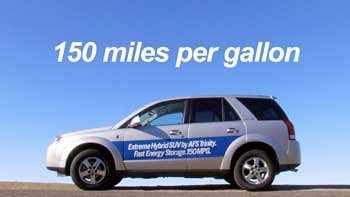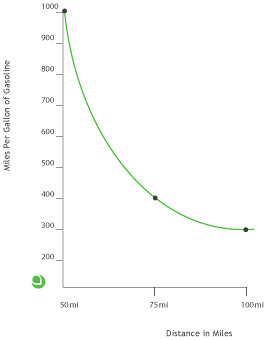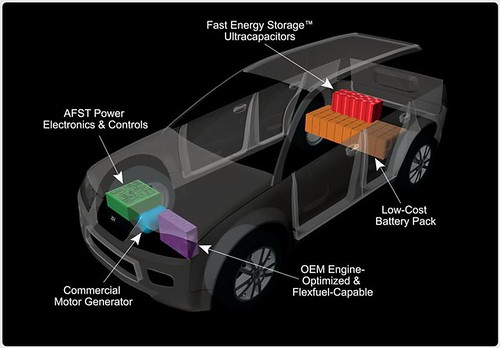AFS Trinity has what it calls Extreme Hybrid (XH) technology which employs a proprietary dual energy storage system that combines Lithium-Ion batteries and ultra capacitors with control electronics. They showed their 150 mpg hybrid at the North American International Auto Show (NAIAS) in Detroit.

150 mpg plug in hybrid SUV from AFS trinity
In just completed road tests, a 2007 Saturn VUE Green Line SUV fitted with an XH drive train, exceeded 150 mpg, and improved the zero to sixty time from 12.5 seconds, to 11.6 second running in electric-only mode — something it can do for 40 miles at a stretch. In hybrid mode, it runs 0-60 mph in 6.9 seconds, which is faster than a Porsche Cayenne.
Extreme Hybrid technology in commercial production is expected to cost around $8,700 more than current, gas-only SUV’s. Their SUV is a plug in hybrid.

“That would be our preference,” said Furia. “However,” he continued, “If carmakers decide not to take advantage of this offer, AFS Trinity intends to raise the funds to begin modifying existing hybrids or manufacture its own 150 mpg SUV’s and, eventually, 250 mpg sedans.
Cutaway view of 150mpg SUV hybridThe Extreme Hybrid™ Plug-in drive train is composed of five primary subsystems: (1) advanced lithium batteries recharged at night with off-peak power from the grid; (2) Fast Energy Storage™ using ultracapacitors for acceleration and regenerative braking; (3) advanced power electronics and control software; (4) internal combustion engine; and (5) electric traction motor and generator. In miles per petroleum gallon, the XH-150™ plug-in hybrid SUV achieves 150 MPPG.
Batteries can be safe if they avoid excessive resistive heating. By using ultra-capacitors as pools of rapid energy,” Furia explained, “the proprietary control electronics of the Extreme Hybrid not only keep the batteries within safe resistive heating limits, but also extend battery life. We regard XH technology as an important safety breakthrough, which is a critical factor in making Extreme Hybrids practical now.”

Payback for those who drive 340 miles/week is 3.5 years with gas at $2.85/gallon. At $5/gallon it would pay back in 2.5 years
FURTHER READING
Other mainstream hybrids and plug in hybrid cars from Toyota, Honda, GM and a chinese automaker
Electric vehicle news roundup, including the Aptera
Cars that are more fuel efficient than the Toyota Prius
UPDATE:
What is new is being able to extend the range of the electrical part. If a Toyota Prius gets a lithium ion battery upgrade then it can get to 100mpg using the same calculations (how much fuel is used when it is recharged every night after some commute distance during the day)
Also, what is new is managing the electrical power more efficiently to allow 40 mile range for an SUV.
also, what is new is the apparently lower production cost of the battery/ultracapacitor combination.
Calcars discusses it and it was reported in Forbes.
The 300mpg Aptera uses a similar calculation of fuel efficiency.
Look at the details of the Aptera under the performance tab
Fuel Mileage chart with variance based on average daily driving distance
Wikipedia discusses calculation of fuel efficiency using plug in hybrids
Alfin has a more extensive list of ultracapacitor battery combination vehicles

Brian Wang is a Futurist Thought Leader and a popular Science blogger with 1 million readers per month. His blog Nextbigfuture.com is ranked #1 Science News Blog. It covers many disruptive technology and trends including Space, Robotics, Artificial Intelligence, Medicine, Anti-aging Biotechnology, and Nanotechnology.
Known for identifying cutting edge technologies, he is currently a Co-Founder of a startup and fundraiser for high potential early-stage companies. He is the Head of Research for Allocations for deep technology investments and an Angel Investor at Space Angels.
A frequent speaker at corporations, he has been a TEDx speaker, a Singularity University speaker and guest at numerous interviews for radio and podcasts. He is open to public speaking and advising engagements.




Comments are closed.